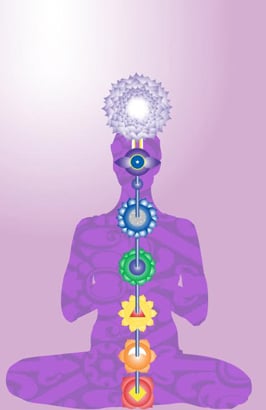The Meaning of Chakra
Literally means “wheel”. Refers to centers of energy in the astral spine. A chakra is a disc-like, rotating energy vortex through which energy is pumped out into the related organs of the body. We relate our life with the breathing process but in reality the energy (life force) flowing in the astral spine keeps us alive.

As this energy enters the body, it travels down the astral spine and is dispersed into the body from six centers, or chakras, located along the astral spine. The deep astral channel has openings on it at certain points, the spinal centers. The life-force flowing in the main deep spine (Sushumna) branches out through the chakras (centers) to provide life force to different body parts.
This subtle spine can be visualized as a tube of light running centrally through the body from the base of the spine to the brain. The central nervous system is the physical expression of the astral spine and, interestingly, has major centers near the areas of each of the chakras, where groups of nerves branch out from the spinal cord.
There is a vast and somewhat complex yogic science dealing with the chakras. Each chakra is associated with a quality of consciousness; an element; a planet; two astrological signs (one as the energy ascends and one as it descends); a sound; a spiritual quality; and so forth. As energy passes through or rests in any chakra, the mind is influenced by the qualities of that center. In the deepest states of meditation, all prana is withdrawn from the body into the chakras and then directed to the spiritual eye, enabling enlightenment to take place. (1)
The Seven Chakras’ Purpose
These centers act in the spine as substations for the main dynamo of energy in the brain. Here is a list of each chakra in order of its location in the spine:
-
- The muladhara chakra (Coccyx center) is situated at the base of the spine. It provides energy to the lower parts of the body; legs and anus area. This center represents the positive qualities of perseverance and loyalty, as well as stubbornness and attachment.
- The swadisthana chakra (Sacral center) is situated one and half inches above the Muladhara chakra. This operates the reproductive organs. It represents creativity and sexuality.
- The manipura chakra (Lumber center) is behind the navel. It governs the digestive system. It represents self-control in its positive aspect and aggression in its negative
- The anahata chakra (Heart/Dorsal center) is at the heart area. It helps operate the heart, lungs, chest and arms. It represents devotion, feeling, and emotion.
- The bishuddha (or vishuddha) chakra (Cervical center) is in the throat. It provides energy to throat and neck region of the body and represents calmness.
- The highest chakra, the agya chakra, (Christ center) has two opposite ends. The negative end is at the base of the skull and represents the ego. The positive end is about an inch behind the point where the eyebrows meet, behind the point between the two eyebrows, the chakra itself. Bringing energy to this point brings enlightenment.
- The sahasrara chakra, or crown chakra, is at the top of the head and represents complete liberation. (2)
These chakras are vital, as all physical body organs need energy (life force) through them to function properly. Disturbance or irregularity in the supply of this energy is the main cause of all bodily diseases.
Being intangible, an aura of mysticism is created around the chakras. But the spiritual seeker is advised to remain away from that mysticism and concentrate on spiritual practices (sadhana) to achieve the final goal of God realization. By following specific techniques, meditators withdraw energy from the body, and through the chakras, and direct it to the spiritual eye (ajna center) for liberation.
